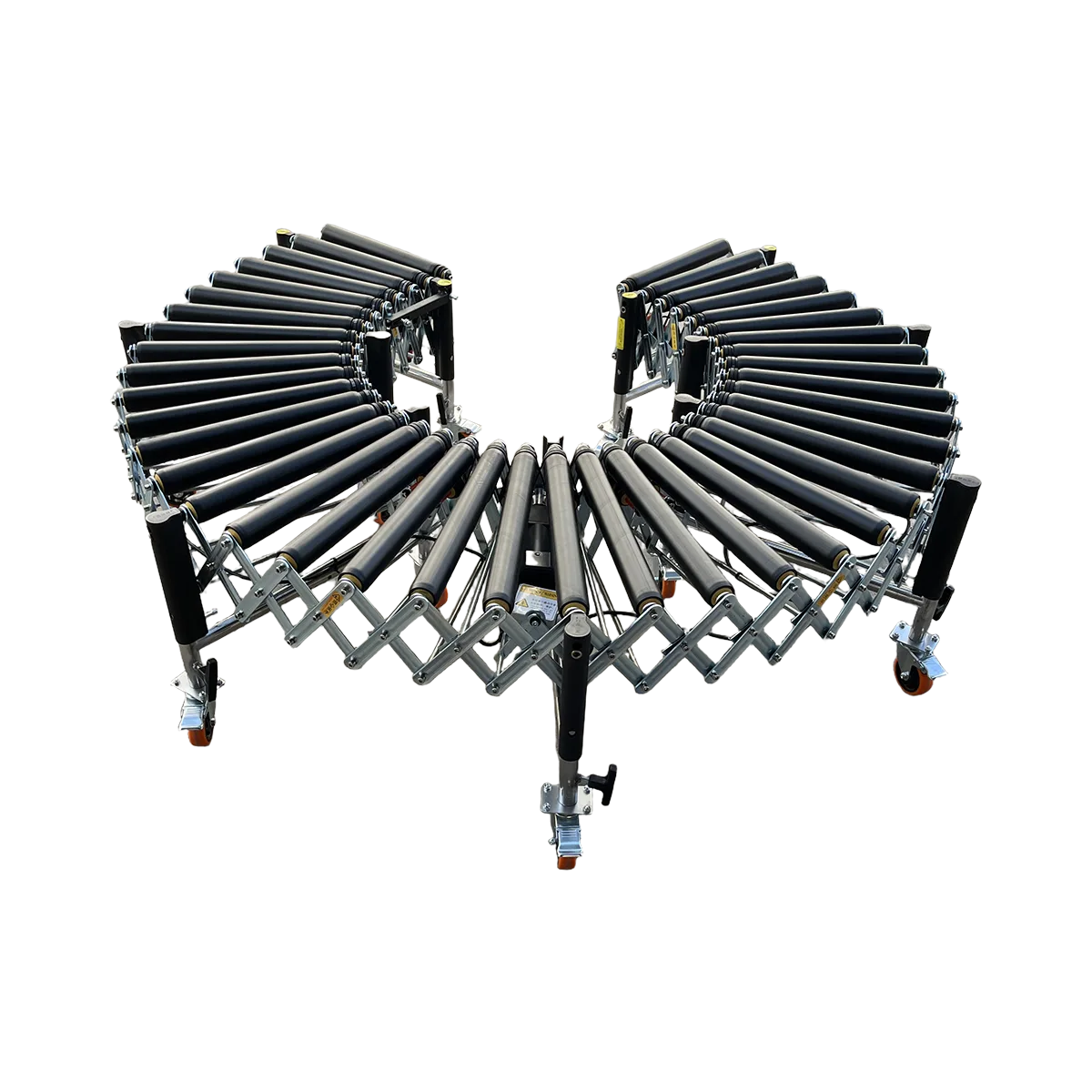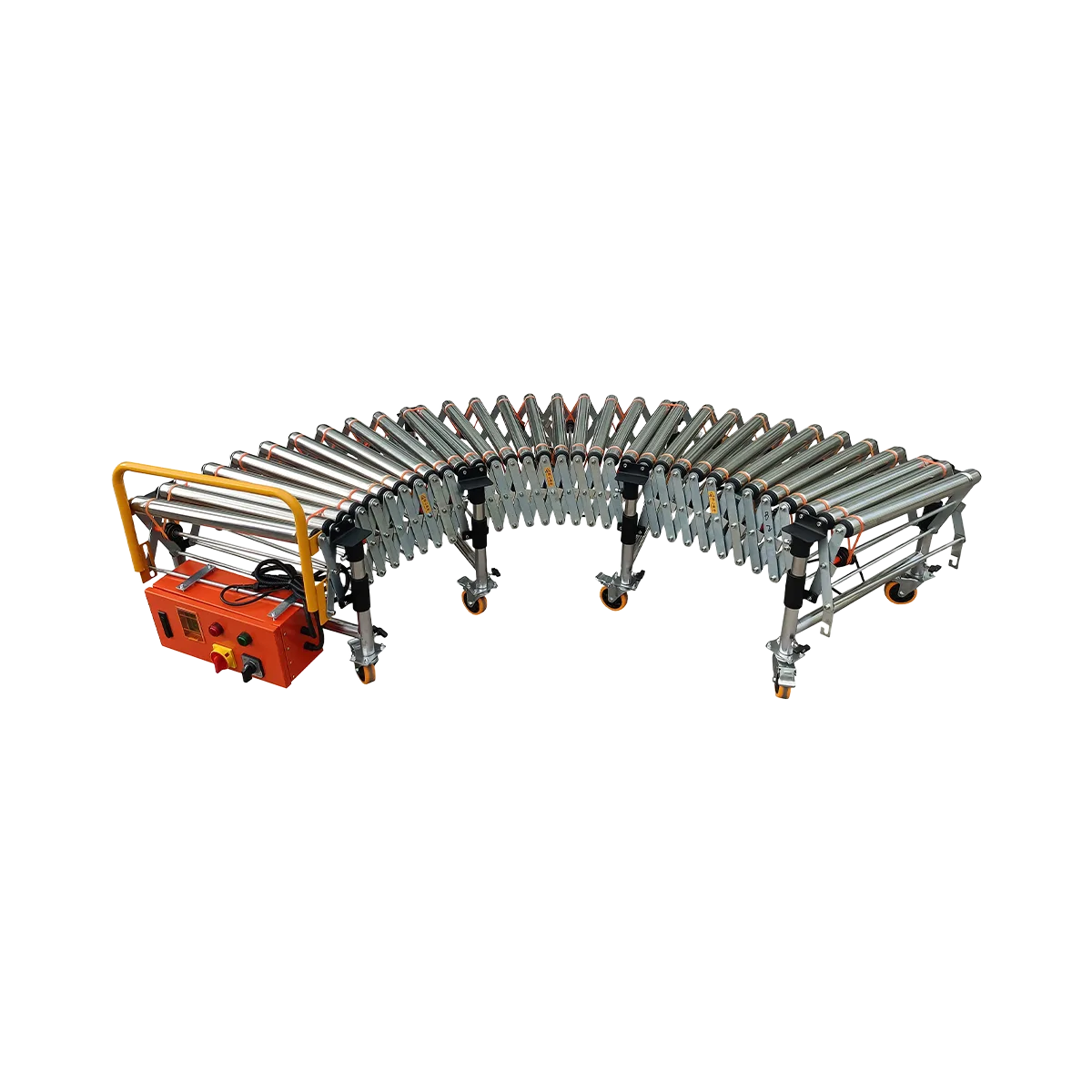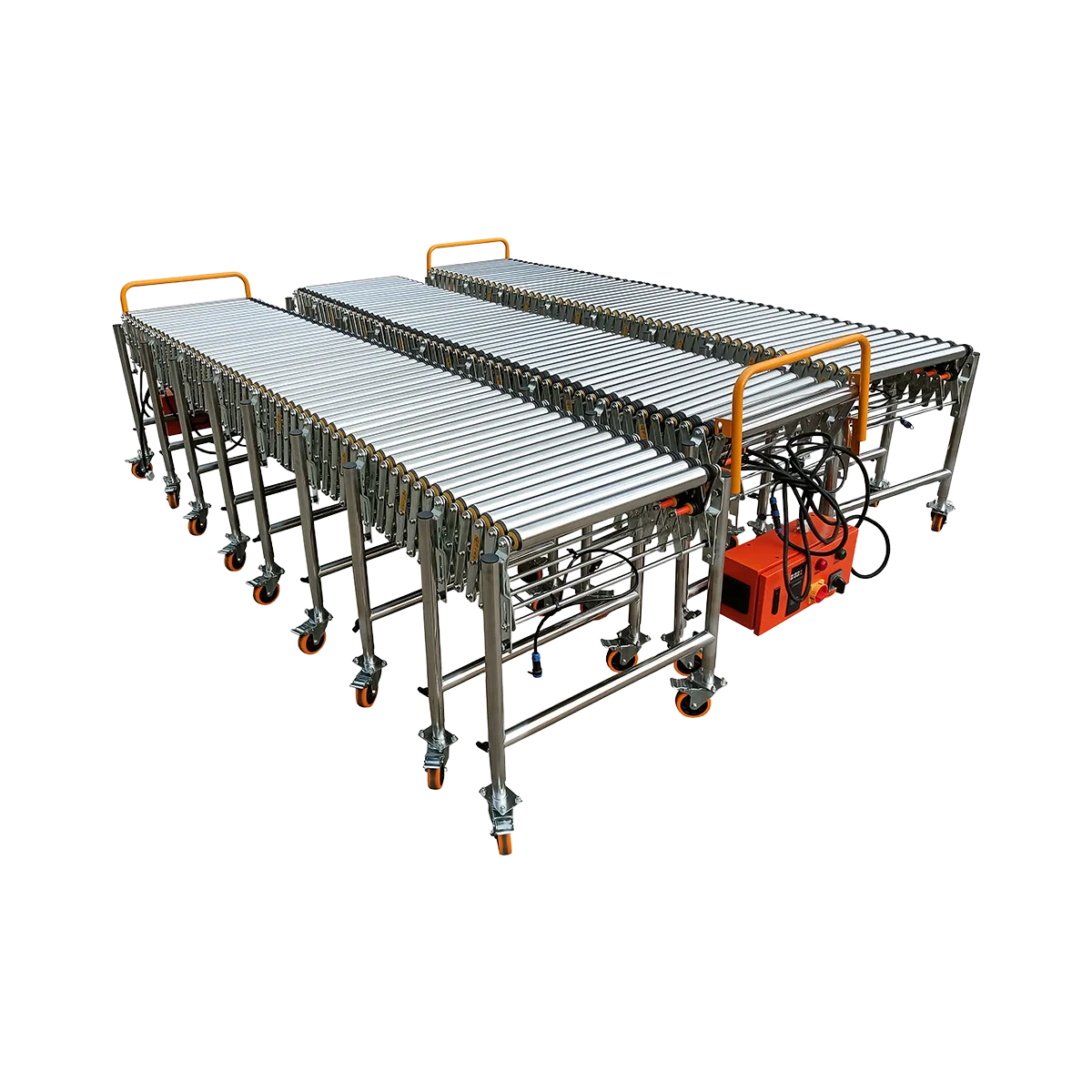Preventing Packages from Falling Off Conveyor Turns
Discover effective conveyor guard rails and setup techniques to prevent package handling safety issues on curved conveyor sections and maximize warehouse efficiency.
Related Products
-
Powered Rubber Roller Conveyor – Multi-wedge Belt Driven – 1100 mm/SectionCollapsed Length
560 mm
Extended Length1100 mm
Load Capacity120 kg/m
Applicable GoodsFlat-bottomed Goods
Bagged Goods
-
Powered Roller Conveyor – O-shaped Belt Driven – 1500 mm/SectionCollapsed Length
525 mm
Extended Length1500 mm
Load Capacity80 kg/m
Applicable GoodsFlat-bottomed Goods
-
Powered Roller Conveyor – Multi-wedge Belt Driven – 2000 mm/SectionCollapsed Length
700 mm
Extended Length2000 mm
Load Capacity100 kg/m
Applicable GoodsFlat-bottomed Goods
-
Powered Roller Conveyor – Multi-wedge Belt Driven – 3000 mm/SectionCollapsed Length
1050 mm
Extended Length3000 mm
Load Capacity80 kg/m
Applicable GoodsFlat-bottomed Goods
One of the most frustrating and costly issues in warehouse operations occurs when packages tumble off conveyor systems at turn points. This common problem not only disrupts workflow but can also damage products, create safety hazards, and reduce overall operational efficiency. Implementing proper conveyor guard rails and turn management techniques is essential for maintaining smooth material flow, especially in busy logistics environments where any disruption can impact throughput targets.
When packages navigate curves on conveyor systems, they encounter physical forces that push them toward the outer edge of the turn. Without proper preventive measures, these forces can cause items to shift, topple, or completely fall off the conveyor line. This article explores practical solutions to this challenge, from simple adjustments in setup to dedicated flexible conveyor accessories that can dramatically improve turn stability.
Understanding the Physics of Conveyor Turns
Why Packages Want to Fly Outward
To effectively solve any problem, we must first understand its cause. The tendency of packages to fall off at turns is due to centrifugal force – the same physical principle that pushes you against the car door when taking a sharp turn. On conveyor systems, several factors influence how strongly this force affects your packages:
- Speed – Faster moving packages experience greater outward force on turns
- Package weight – Heavier items have more momentum and are more likely to slide
- Friction coefficient – Smooth-bottomed packages slide more easily than textured ones
- Turn radius – Sharper turns (smaller radius) create stronger outward forces
- Package height-to-width ratio – Taller, narrower packages are more prone to tipping
The relationship between these factors can be expressed in a simple formula: the outward force increases with speed squared and decreases with the turning radius. This means doubling the speed quadruples the force pushing packages outward, while doubling the turn radius halves that force.
Solution 1: Proper Conveyor Setup
Before investing in additional hardware, significant improvements can be achieved through proper setup of your existing conveyor system. These adjustments can dramatically reduce the likelihood of packages falling off turns.
Banking the Turn: Creating a Tilted Surface
One of the most effective techniques borrowed from racetrack design is banking the turn. This involves adjusting the outer legs of the curved conveyor section to be slightly higher than the inner legs, creating a subtle tilt toward the inside of the curve.
To properly bank a conveyor turn:
- Identify the height adjustment mechanisms on your conveyor support legs
- Calculate the appropriate height differential (typically 2-3 degrees of tilt)
- Raise the outer legs or lower the inner legs to create the desired angle
- Ensure the tilt is gradual and consistent throughout the turn
- Test with various package types before full implementation
This slight banking counteracts the centrifugal force by introducing a gravitational component pulling packages toward the inside of the turn. For most warehouse applications, a 2-3 degree tilt provides optimal results without creating other handling issues.
Speed Control: The Crucial Entry Phase
Managing the speed at which packages enter a turn is perhaps the single most important factor in preventing falls. Implementing proper speed control involves:
- Installing a powered section before the turn to regulate entry speed
- Setting the appropriate speed based on package characteristics and turn radius
- Creating a slight speed differential between the straight and curved sections
- Considering package spacing to prevent bunching at the turn
For most applications, reducing speed by 15-25% before entering a turn significantly improves stability. Powered roller conveyor sections with variable speed control are ideal for this application, as they allow precise adjustment based on your specific packages and turn configuration.
Solution 2: Mechanical Guards and Barriers
When proper setup alone isn’t sufficient, mechanical guards provide an effective physical barrier to prevent packages from falling off turns.
Custom Side Guards for Enhanced Safety
While not included as standard features, Naili conveyors can be fitted with simple yet effective side guards. These conveyor guard rails provide a physical barrier that keeps packages on the conveyor path through turns.
Effective side guard implementation includes:
- Height consideration – Guards should be tall enough to contain your tallest packages
- Positioning – Guards must be placed precisely at the outer edge of turns
- Material selection – Smooth materials prevent package damage during contact
- Attachment method – Secure mounting without interfering with conveyor operation
- Visibility – Guards should be easily visible to operators for safety awareness
For curved sections handling varied package sizes, adjustable-height side guards offer maximum versatility. These can be raised for taller items and lowered when processing primarily smaller packages.
DIY Guard Solutions for Temporary Applications
For temporary setups or pilot operations, several cost-effective DIY guard solutions can be implemented:
- Repurposed plastic sheeting attached to create a smooth barrier
- Foam padding secured to existing frames
- Adjustable guide rails made from standard warehouse materials
- Transparent barriers for better visibility of product flow
These temporary solutions allow you to test different configurations before investing in permanent guards, helping you identify the optimal guard height and positioning for your specific application.
The Right Conveyor for the Job
Not all conveyor types perform equally when it comes to navigating turns. Understanding the differences can help you select the optimal system for applications involving curved sections.
Roller Conveyors vs. Skate Wheel Conveyors on Turns
When comparing the main conveyor types for curved applications:
| Feature | Roller conveyor | Skate wheel conveyor |
|---|---|---|
| Contact surface | Continuous line contact | Discrete point contact |
| Package stability | Higher stability for varied box sizes | Better for uniform, flat-bottomed packages |
| Turn performance | Superior on curves | Less stable on turns |
| Friction coefficient | Consistent across surface | Variable depending on weight distribution |
| Ideal package types | Mixed sizes, irregular bottoms | Uniform sizes with flat bottoms |
The continuous surface contact provided by roller conveyors creates significantly more stability through turns, particularly for varied package sizes or packages with irregular bottom surfaces. The line contact ensures consistent support across the entire package bottom, reducing the tendency for packages to tip or slide during turns.
Gravity vs. Powered Systems for Curved Sections
When designing a system with turns, consider these differences between gravity and powered options:
- Gravity systems – Speed increases naturally through the turn, requiring more aggressive banking or stronger guards
- Powered systems – Allow precise speed control through turns, significantly reducing fall risk
For most applications involving multiple turns or varied package types, a combination of powered straight sections leading into banked gravity turns offers the optimal balance of control and efficiency.
Implementing a Comprehensive Solution
The most effective approach combines multiple strategies tailored to your specific operation. Consider this systematic approach to curved conveyor warehouse safety tips:
- Analyze the problem – Document where and when packages fall, noting package types and characteristics
- Optimize conveyor setup – Implement banking and speed control as first-line improvements
- Add physical barriers – Install appropriate guard rails where necessary
- Train operators – Ensure staff understand proper package placement and spacing
- Monitor and adjust – Regularly review performance and make incremental improvements
Most operations find that a combination of proper setup techniques and strategic guard placement resolves 95% of issues with packages falling off turns.
When to Consider System Redesign
In some cases, particularly for operations handling extremely diverse package types, a more fundamental redesign might be necessary. Consider system modifications when:
- Your turn radius is too sharp for your package sizes
- Speed requirements cannot be reduced at turn points
- Package characteristics (very tall, unstable, or irregular) exceed the capabilities of standard curved sections
In these situations, alternatives such as multiple straight sections with transfer points or 90-degree powered transfers might be more appropriate than traditional curved conveyor sections.
Conclusion: Achieving Stability Through Smart Design
Creating stable, efficient curved conveyor solutions doesn’t require complex engineering or costly specialized equipment. A thoughtful combination of proper setup techniques and simple mechanical guards can make your curved conveyor lines virtually 100% secure against package falls.
By understanding the physics involved, implementing appropriate banking and speed control, and adding strategic guard rails where necessary, warehouse operations can dramatically reduce product damage and workflow disruptions. The key is a systematic approach that addresses the specific characteristics of your packages and conveyor system.
Remember that even small adjustments in setup can yield significant improvements in turn stability. Start with the simplest solutions – optimizing speed and banking the turns – before moving to more complex interventions. With the right approach, conveyor turns can be just as reliable and efficient as straight sections in your material handling system.
Frequently Asked Questions
What is the ideal angle for banking a conveyor turn?
For most warehouse applications handling standard cardboard boxes and containers, a banking angle of 2-3 degrees provides optimal results. Heavier or faster-moving packages may require a slightly steeper angle up to 5 degrees, while very light items might need only 1-2 degrees of banking.
Can I add side guards to my existing conveyor system, or do I need to purchase new equipment?
Side guards can be retrofitted to most existing conveyor systems, including Naili models. The guards attach to the existing frame structure and can be installed with basic tools, making them an economical upgrade to improve safety without replacing your current system.
Which conveyor type is best for applications with multiple turns?
Roller conveyors generally perform better than skate wheel conveyors for applications with multiple turns, especially when handling varied package sizes. The continuous line contact provided by rollers gives packages more stability through turns compared to the point contact of skate wheels.
How much should I reduce speed before a conveyor turn?
As a general rule, reducing speed by 15-25% before entering a turn provides good results for most applications. However, the optimal reduction depends on your specific packages and turn radius. Heavier packages and sharper turns may require speed reductions of up to 30-40% for maximum stability.
Do I need different solutions for powered versus gravity conveyor turns?
Yes, the approaches differ slightly. Gravity conveyor turns rely more heavily on proper banking and physical guards since you cannot control speed directly. Powered conveyor turns benefit from speed control as your primary strategy, with banking and guards as secondary measures. Both types can be made secure with the right combination of techniques.
Table of Contents
Recent Posts
Optimize hardware store logistics with the right building supply conveyor systems. Our guide to tool distribution systems enhances retail warehouse automation for efficient operations.
Optimize your medical supply logistics with efficient gravity conveyor systems. Learn how to safely handle healthcare products while improving your hospital supply chain operations.
Discover how a sports equipment conveyor system can streamline your athletic gear logistics. Flexible conveyor solutions for all shapes and sizes of sporting goods.




